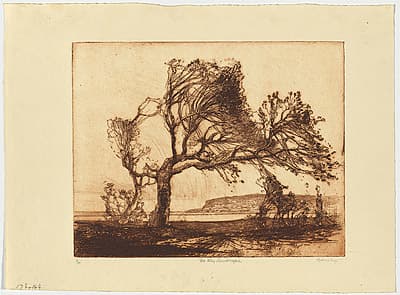
Sydney
LONG
Australia
1871
–
London
1955
England, Europe 1910-21; Australia 1921- 22; England 1922-25; Australia 1925-52; England from 1952
23.7 (h) x 29.9 (w) cm
1/50 , published state , edition of 50 , watermark lower centre, 'F J Head & Co'
Signed lower right below plate-mark in black pencil, 'Sidney Long.' Not dated. Titled lower centre below plate-mark in black pencil, 'Dee Why Landscape'. Inscribed with edition details lower left below plate-mark in black pencil, '1/50'.
Reference: Mendelssohn (1979), 82; Paul (1928), 85 National Gallery of Australia, Canberra NGA 1977.9.102 The Stephen Collection, purchased 1976. Reproduced with the kind permission of the Ophthalmic Research Institute of Australia
- J.W.F. Stephen, who formed a definitive collection of the etched work of Sydney Long. J.A.C. Stephen, the artist’s son, by descent. Purchased by the Australian National Gallery, from J.A.C. Stephen, Sydney, 1977.
In Dee Why landscape, Long depicted a coastal scene at the Dee Why foreshore, in the northern Sydney beaches of New South Wales. He used the etching needle to sharply delineate the wiry and twisted limbs of the tree, and to evoke the experience of being blown by the wind.
Here, and in The lagoon (cat 96), both of 1928, Long explored more dramatic subjects than in many of his previous prints. The prints match the mood of a number of his paintings of this period, in which the limbs of trees are shown ranging energetically across the canvas. It is as if the mild-mannered artist
has suddenly discovered a new energy,
a new force.
It may be purely serendipitous, a result of two artists making an accurate depiction of natural phenomena, but Long’s image of the bent tree in Dee Why landscape has a good deal in common with Harold Cazneaux’s photograph, The bent tree 1914, taken some 12 years earlier. Certainly, Long and Cazneaux knew of each other, and Cazneaux is said to have admired Long’s work. This print may suggest that the admiration was mutual.
A copy of Dee Why was first exhibited in 1928 at the ‘Eighth annual exhibition of the Australian Painter–Etchers’ Society’, Sydney, 8–23 June (51, as ‘Dee Why landscape’). Copies of the print are held by the Art Gallery of New South Wales and the Tasmanian Museum and Art Gallery.
In Dee Why landscape, Long depicted a coastal scene at the Dee Why foreshore, in the northern Sydney beaches of New South Wales. He used the etching needle to sharply delineate the wiry and twisted limbs of the tree, and to evoke the experience of being blown by the wind.
Here, and in The lagoon (cat 96), both of 1928, Long explored more dramatic subjects than in many of his previous prints. The prints match the mood of a number of his paintings of this period, in which the limbs of trees are shown ranging energetically across the canvas. It is as if the mild-mannered artist
has suddenly discovered a new energy,
a new force.
It may be purely serendipitous, a result of two artists making an accurate depiction of natural phenomena, but Long’s image of the bent tree in Dee Why landscape has a good deal in common with Harold Cazneaux’s photograph, The bent tree 1914, taken some 12 years earlier. Certainly, Long and Cazneaux knew of each other, and Cazneaux is said to have admired Long’s work. This print may suggest that the admiration was mutual.
A copy of Dee Why was first exhibited in 1928 at the ‘Eighth annual exhibition of the Australian Painter–Etchers’ Society’, Sydney, 8–23 June (51, as ‘Dee Why landscape’). Copies of the print are held by the Art Gallery of New South Wales and the Tasmanian Museum and Art Gallery.
In Dee Why landscape, Long depicted a coastal scene at the Dee Why foreshore, in the northern Sydney beaches of New South Wales. He used the etching needle to sharply delineate the wiry and twisted limbs of the tree, and to evoke the experience of being blown by the wind.
Here, and in The lagoon (cat 96), both of 1928, Long explored more dramatic subjects than in many of his previous prints. The prints match the mood of a number of his paintings of this period, in which the limbs of trees are shown ranging energetically across the canvas. It is as if the mild-mannered artist
has suddenly discovered a new energy,
a new force.
It may be purely serendipitous, a result of two artists making an accurate depiction of natural phenomena, but Long’s image of the bent tree in Dee Why landscape has a good deal in common with Harold Cazneaux’s photograph, The bent tree 1914, taken some 12 years earlier. Certainly, Long and Cazneaux knew of each other, and Cazneaux is said to have admired Long’s work. This print may suggest that the admiration was mutual.
A copy of Dee Why was first exhibited in 1928 at the ‘Eighth annual exhibition of the Australian Painter–Etchers’ Society’, Sydney, 8–23 June (51, as ‘Dee Why landscape’). Copies of the print are held by the Art Gallery of New South Wales and the Tasmanian Museum and Art Gallery.
